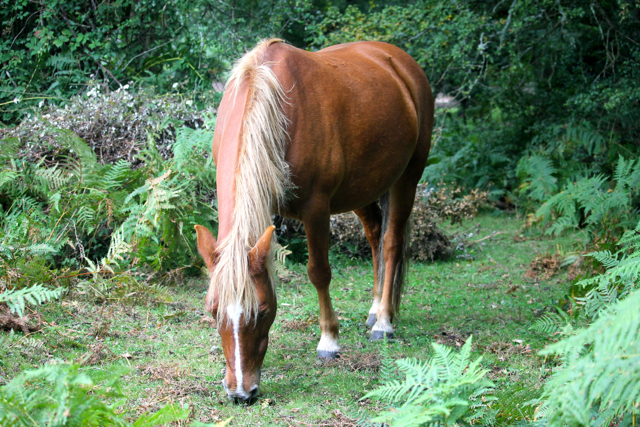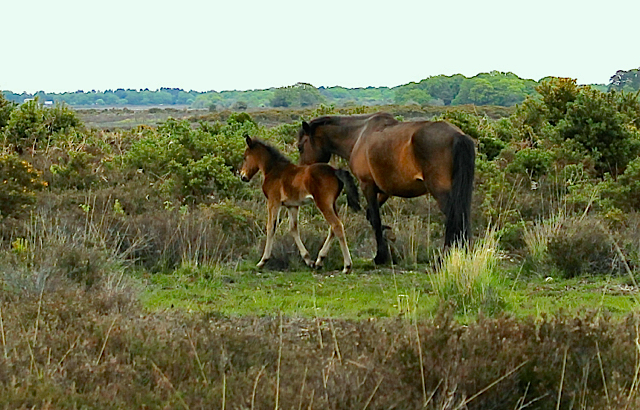
In 1871 the New Forest pony was described as ‘lath-legged, small-bodied, and heavy-headed’.
In the last decade of the nineteenth century efforts were made to improve the breeding of the New Forest pony to fulfil a ready market for ‘the large class, daily increasing, who use good ponies in light carts instead of larger horses and carriages.’ In an age that was entirely horse-drawn this was an important development and those whose livelihoods relied on producing good saleable ponies were quick to respond. It was generally agreed that ‘nowhere is there a larger stock of brood mares of a hardy, active and wiry stamp’ although it was recognised that ‘thirteen hands high is the height that appears best suited for the district, or rather that Forest feeds allows…[but] when bought young and run on better pasture, another hand is often added by natural growth.’ However, the size of the New Forest pony wasn’t as much an issue as its looks. One commentator remarked in 1871 that the ponies were ‘lath-legged [meaning that the pasterns were straight and upright, the fetlocks short, the legs straight and flat], small-bodied, and heavy-headed.’ It was therefore decided that immediate action was needed to breed a pony more attractive for light-harness work.
New Forest Pony Association
Those tasked with improving the New Forest pony agreed that it was easier to change the stallion, which could produce 50 foals in a year, than it was to change the mare, which could only produce one. Therefore, in 1890 the New Forest Pony Association introduced the ‘Four Pony Scheme’ for the purpose of ‘keeping four suitable stallions in-hand or to run in the Forest.’ (Breeding in-hand requires the close supervision of the stallion and mare together, whereas turning the stallion loose on the Forest, where he could roam free and select mares of his choice, would allow nature to take its course.) Generally speaking, the higher the value of the stallion or mare, the more likelihood that a higher level of supervision to their courtship would be required – after all investments needed to be protected and valuable mares needed to be sheltered from the ‘scrub’ stallions.
The Four Pony Scheme
The first stallion to join the ‘Four Pony Scheme’, in 1890, was Sprig of Shillelagh, an ex-Irish Steeplechaser, who was kept at Harrow Farm, Bransgore, to service visiting mares. The following year Exmoor, Hebridean, Blue Roan, West Highlander and Brockenhurst Joe joined him and were turned out on the Forest ‘in various quarters and kept in pasture during the winter season.’ According to reports Blue Roan and Hebridean both died in the Forest in the early autumn of 1892, ‘having done good service.’ Unfortunately the report does not mention exactly how the two stallions died but it was recorded that Blue Roan had been earlier ‘knocked about’ by another horse, to such an extreme that the offending animal had to be removed from the Forest. To the scheme was also added Abeyan and Yurasson, two purebred Arabian stallions loaned by Her Majesty Queen Victoria, who were kept at stud by Lord Montague of Beaulieu and David Jones of Warborne, in Boldre, respectively.
Pony Stud Book Society
A report of 1892 declared that the pony owners who used the Association’s stallions were ‘well pleased with the produce obtained, the more so as the [stud] fee paid was nominal only.’ The scheme was, apparently, also increasing the numbers of pony owners who were subscribing to the scheme convinced, no doubt to participate, by the prices that the improved progeny were fetching in the sales ring, ‘which were considerably above what is generally obtained for the ordinary stock’. Consequently an approach was made by the Pony Stud Book Society in 1892 about recording the bloodlines of the best Forest ponies and there was much debate about the best way of going about this task. One suggestions was that the best Forest mares ought to be paraded at the annual show where their suitability to be entered into the studbook could be decided. But to much laughter and shouts of ‘Hear! Hear!’ the response given was that although ‘it was a good suggestion, … it would exclude some, as many a good mare would see her owner further before she is brought to a pony show.’

Since 1930 only purebred New Forest stallions have been permitted on the Open Forest to sire the next generation of New Forest pony.


You must be logged in to post a comment.